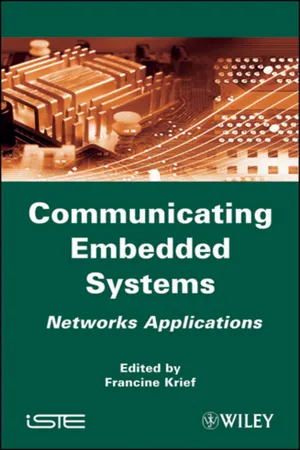Computer Science
Characteristics of Embedded Systems
Embedded systems are specialized computing systems designed to perform specific functions within larger systems. They are characterized by real-time operation, low power consumption, and often have limited resources such as memory and processing power. Embedded systems are commonly found in everyday devices such as smartphones, household appliances, and automotive systems.
Written by Perlego with AI-assistance
Related key terms
6 Key excerpts on "Characteristics of Embedded Systems"
- eBook - ePub
- Richard Zurawski(Author)
- 2018(Publication Date)
- CRC Press(Publisher)
Figure 82.1 . The main programmable components are microprocessors and DSPs, which implement the software partition of the system. One can view reconfigurable components, especially if they can be reconfigured at runtime, as programmable components in this respect. They exhibit area, cost, performance, and power characteristics that are intermediate between dedicated hardware and processors. Custom and programmable hardware components, on the other hand, implement application-specific blocks and peripherals. All components are connected through standard and/or dedicated buses and networks, and data are stored on a set of memories. Often, several smaller subsystems are networked together to control, for example, an entire car, or to constitute a cellular or wireless network.We can identify a set of typical characteristics that are commonly found in embedded systems. For instance, they are usually not very flexible and are designed to always perform the same task: if you buy an engine control embedded system, you cannot use it to control the brakes of your car, or to play games. A PC, on the other hand, is much more flexible because it can perform several very different tasks. An embedded system is often part of a larger controlled system. Moreover, cost, reliability, and safety are often more important criteria than performance, because the customer may not even be aware of the presence of the embedded system, and so he looks at other characteristics, such as the cost, the ease of use, or the lifetime of a product.FIGURE 82.1 A reactive real-time embedded system architecture.Another common characteristic of many embedded systems is that they need to be designed in an extremely short time to meet their time-to-market. Only a few months should elapse from conception of a consumer product to the first working prototypes. If these deadlines are not met, the result is a concurrent increase in design costs and decrease of the profits, because fewer items will be sold. Thus, delays in the design cycle may make a huge difference between a successful product and an unsuccessful one. - eBook - ePub
Memory Allocation Problems in Embedded Systems
Optimization Methods
- Maria Soto, Marc Sevaux, André Rossi, Johann Laurent(Authors)
- 2013(Publication Date)
- Wiley-ISTE(Publisher)
In contrast, the embedded system was originally designed so that the end user could make choices regarding the different application options, but could not change the functionality of the system by adding software. However, nowadays, this distinction is less and less relevant; for example it is more frequent to find smartphones where we can change their functionality by installing appropriate software. In this manner, the breach between a PC and an embedded system is shorter today than it was in the past. An embedded system can be a complete electronic device or a part of an application or component within a larger system. This explains its wide range of applicability. Embedded systems range from portable devices such as digital watches to large stationary installations such as systems controlling nuclear power plants. Indeed, depending on application, an embedded system can monitor temperature, time, pressure, light, sound, movement or button sensitivity (like on Apple iPods). We can find embedded systems helping us in every day common tasks; for example alarm clocks, smartphones, security alarms, TV remote controls, MP3 players and traffic lights. Not to mention modern cars and trucks that contain many embedded systems: one embedded system controls the antilock brakes, another monitors and controls the vehicle’s emissions and a third displays information in the dashboard [BAR 06]. Besides, embedded systems are present on real-time systems. The main characteristic of these kinds of systems is timing constraints. A real-time system must be able to make some calculations or decisions in a timely manner knowing that these important calculations or activities have deadlines for completion [BAR 06]. Real-time systems can be found in telecommunications, factory controllers, flight control and electronic engines - eBook - ePub
Communicating Embedded Systems
Networks Applications
- Francine Krief(Author)
- 2013(Publication Date)
- Wiley-ISTE(Publisher)
It also aims to provide the important ideas and concepts to support the following chapters. 1.2. Embedded system: a definition We can see that embedded systems are all around us and assist us in our daily lives. We unknowingly encounter dozens of them each day, while we generally use a single computer for work purposes. So they are pervasive, omnipresent, discreet, efficient and dedicated to the task for which they were designed. If we try to give a more precise definition of an embedded system, we could say that [KAD 06a]: An embedded system can be defined as an autonomous electronic and informational system, dedicated to a well defined task. In general, an embedded system does not have standard or classic inputs and outputs like a keyboard or screen. The physical system and the application are intimately connected, and the embedded software is buried within the material. Another important property of an embedded system is its ability to communicate with the outside world. This new capability is, of course, connected to the progress of integrating the microelectronics as well as to the trivialization and generalization of network protocol use. The de facto standard internet protocols (TCP/IP protocols), could also have been used in embedded systems, or even integrated directly into the silicon in some cases. The processors used in an embedded system integrate an Ethernet network interface as standard. It is also possible to integrate a wired or wireless internet connection simply by the addition of a small electronic module. Today,controlling an embedded system from a distance has become a reality, and it is completely possible to control an embedded system over the internet via a web browser - eBook - ePub
Hands-On Embedded Programming with C++17
Create versatile and robust embedded solutions for MCUs and RTOSes with modern C++
- Maya Posch(Author)
- 2019(Publication Date)
- Packt Publishing(Publisher)
What Are Embedded Systems?
Essentially , the embedded part of an embedded system refers to the state of being embedded into a larger system. The system that has been embedded is a computer system of some description, which has one or more very specific functions in the overall system, rather than being a general-purpose component. This larger system can be digital, mechanical, or analog in nature, while the additional integrated digital circuitry tightly interacts with data from and to interfaces, sensors and memory to implement the actual system functionality.In this chapter, we will look at the following topics:- Different categories of embedded platforms
- Examples of each category
- Development challenges of each category
Passage contains an image
The many faces of embedded systems
Every computerized function in today's devices is implemented using one or multiple microprocessors, meaning a computer processor (central processing unit, or CPU) usually contained in a single integrated circuit (IC ). The microprocessor comprises at least the arithmetic logic unit (ALU ) and control circuitry, but logically also registers, and input/output (I/O ) banks, in addition to more advanced features commonly tailored to a specific product category (wearables, low power sensors, mixed signal, ...) or market (consumer, medical, automotive, ...).At this point in history, almost all microprocessors are found in embedded systems. Even though people are likely to possess a computer, laptop, and smartphone, maybe even a tablet, the number of embedded microprocessors in a given household far dwarfs the number of general-purpose microprocessors.Even within a laptop or PC, there are a number of embedded microprocessors in addition to its general-purpose CPU. These microprocessors have tasks like handling keyboard or mouse input, processing touch-screen inputs, converting streams of data into Ethernet packages, or creating video or audio output. - eBook - ePub
Embedded Software Development
The Open-Source Approach
- Ivan Cibrario Bertolotti, Tingting Hu(Authors)
- 2017(Publication Date)
- CRC Press(Publisher)
This kind of automation is quite helpful as saving energy is becoming a bigger concern day by day. The same embedded computer may also be used to complete other kinds of activities, for example, personnel access control to buildings based on digital identification like badges.What’s more, embedded systems are deeply involved in the transportation industry, especially automotive. It is quite common to find that even inexpensive cars are equipped with more than 10 embedded nodes, including those used for anti-lock braking system (ABS). For what concerns industry automation, embedded systems are deployed in production lines to carry out all sorts of activities, ranging from motion control to packaging, data collection, and so on.The main concerns of embedded systems design and development are different from general-purpose systems. Embedded systems are generally equipped with limited resources, for instance, small amount of memory, low clock frequency, leading to the need for better code optimization strategies. However, fast CPUs sometimes simply cannot be adopted in industrial environments because they are supposed to work within a much narrower range of temperature, for instance [0, 40] degrees Celsius.Instead, industrial-grade microprocessors are generally assumed to perform sustainable correct functioning even up to 85 degrees. This leads to one main concern of embedded systems, that is reliability , which encompasses hardware, software, and communication protocol design. In addition, processor heat dissipation in such environments is another issue if they are working at a high frequency.All these differences bring unavoidable changes in the way embedded software is developed, in contrast with the ordinary, general-purpose software development process, which is already well known to readers. The main purpose of this chapter is to outline those differences and explain how they affect programmers’ activities and way of working. - eBook - ePub
- Wai-Kai Chen(Author)
- 2003(Publication Date)
- CRC Press(Publisher)
5 Embedded Computing Systems and Hardware/ Software Co-Design
Wayne Wolf Princeton University5.1 Introduction
This chapter describes embedded computing systems that make use of microprocessors to implement part of the system’s function. It also describes hardware/software co-design, which is the process of designing embedded systems while simultaneously considering the design of its hardware and software elements.5.2 Uses of Microprocessors
An embedded computing system (or more simply an embedded system) is any system which uses a programmable processor but itself is not a general purpose computer. Thus, a personal computer is not an embedded computing system (though PCs are often used as platforms for building embedded systems), but a telephone or automobile which includes a CPU is an embedded system. Embedded systems may offer some amount of user programmability—3Com’s PalmPilot, for example, allows users to write and download programs even though it is not a general-purpose computer—but embedded systems generally run limited sets of programs. The fact that we know the software that we will run on the hardware allows us to optimize both the software and hardware in ways that are not possible in general-purpose computing systems.Microprocessors are generally categorized by their word size, since word size is associated both with maximum program size and data resolution. Commercial microprocessors come in many sizes; the term microcontroller is used to denote a microprocessor which comes with some basic on-chip peripheral devices, such as serial input/output (I/O) ports. Four-bit microcontrollers are extremely simple but capable of some basic functions. Eight-bit microcontrollers are workhorse low-end microprocessors. Sixteen- and 32-bit microprocessors provide significantly more functionality. A 16/32-bit microprocessor may be in the same architectural family as the CPUs used in computer workstations, but microprocessors destined for embedded computing often do not provide memory management hardware. A digital signal processor (DSP) is a microprocessor tuned for signal processing applications. DSPs are often Harvard architectures, meaning that they provide separate data and program memories; Harvard architectures provide higher performance for DSP applications. DSPs may provide integer or floating-point arithmetic.
Learn about this page
Index pages curate the most relevant extracts from our library of academic textbooks. They’ve been created using an in-house natural language model (NLM), each adding context and meaning to key research topics.





